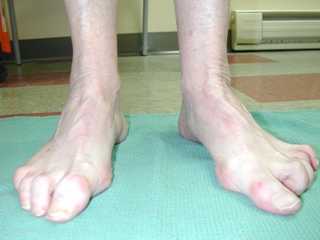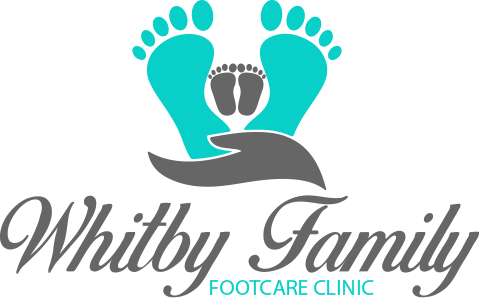If you have feet with a high arch or instep while standing, you have a foot condition called pes cavus. The arch, or instep, runs from the toes to the heel on the bottom of your foot. Pes cavus is the opposite of flatfeet (pes planus). Pes cavus is less common than pes planus. Pes cavus usually occurs in both feet and at an early age. The sudden appearance of the pes cavus, or if it appears in one foot only, may be the result of trauma or a neuromuscular disease.
Pes cavus may be initially asymptomatic, but often becomes progressively symptomatic with age. In general, pes cavus is a more bothersome foot type than a flatfoot. Less of the plantar surface of the foot is weight bearing resulting in increased stress on the heel and the ball of the foot (metatarsal heads).
The high arched foot is unable to absorb the shock of heel strike during the gait cycle. This creates abnormal stress on the soft tissues of the foot and lower leg. The shock is transmitted from heel and arch of the foot to the ankle, knees, hips, and lower back. It is common for pain to occur in one or more these areas. . The toes may develop a “clawing” deformity with painful corns on the top of the toes or at the tips of the toes. Painful plantar calluses are often present under the ball of the foot.
If you have pes cavus it can be difficult for you to fit into shoes. You may also benefit from arch support provided by flexible custom foot orthoses. Custom foot orthotics will off load pressure from the heel and forefoot.
Appearance
 If you are standing, the instep looks hollow and most of the weight is on the back and balls of the foot (metatarsals head).
If you are standing, the instep looks hollow and most of the weight is on the back and balls of the foot (metatarsals head).- Your high arches can be either rigid (the arch does not move to a lower height) or flexible, (the arch can move to a lower height)
- If you are sitting on the edge of table with your feet hanging in the air, the front half of the foot (forefoot) will appear to be dropped below the level of the heel.
- Your foot may be in a supinated position (feet will roll outwards or the heel will tilt inwards from behind)
Causes
- Normal variant (i.e. some people just have higher arches),
- Hereditary (i.e. runs in your family)
- Congenital conditions (e.g. cerebral palsy, congenital club foot)
- Neuromuscular disease (e.g. poliomyelitis, Charcot-Marie-Tooth disease)
- Nerve trauma
Tests that might be done by a neurologist if neuromuscular disease or nerve trauma is suspected:
 Electromyography
Electromyography- MRI of the spine
- Nerve conduction studies
- X-ray of the feet
- X-ray of the spine
Symptoms and Complications
The symptoms of a high arch foot will vary depending on the severity of the arch height, the availability of joint motion in the foot to help lower the arch and the activity levels or occupational demands placed on the high arched feet. Most people with high arches will have no pain or any other symptoms.
Symptoms may vary from a mild problem with shoe fitting to significant disability such as:
- Difficulty finding proper fitting footwear because the shoes are not deep enough due to high arch and the clawed toes.
- Shortened foot length
- Foot pain with walking, standing, and running
- Metatarsalgia with pain in the forefoot/ ball of the foot (usually 1st and 5th metatarsal heads), with or without calluses/corns
- Pain and stiffness of the medial arch or anywhere along the mid-portion of the foot
- Morton’s neuroma with pain in the ball of the foot and lesser toes.
- Pain in the heel and sole of the foot from plantar fasciitis.
- Stress fractures of the metatarsals and other foot bones
- Particularly in diabetics and those with compromised circulation, abnormal pressure may result in chromic ulcers of the heel and ball of the foot.
- Strain and early degenerative joint disease (osteoarthritis) of lower extremity joints
- “Pump bumps” (Haglund’s deformity) on the back of the heel
- Associated discomfort within and near the ankle joint
- Ankle instability with frequent sprains
- Tight Achilles tendons
- The knees, hips, and lower back may be the primary source of discomfort
- Chronic lower extremity pain my lead to inactivity and diminished well-being
Treatment
Initially a careful investigation is needed to rule out any neurological condition that is causing the high arched foot. This will depend on what is causing the pain, if anything. For instance, flexible high arches may not need any treatment.
 Wear shoes with a good cushioning, depth and arch support which may help relieve pain and improve walking.
Wear shoes with a good cushioning, depth and arch support which may help relieve pain and improve walking.- Debridement of corns and calluses
- Various pads made from silicone or felt can be used to get pressure off the painful areas
- Control body weight to decrease load on the feet
- Physical therapy modalities such as laser therapy for associated tendonitis.
- Foot and ankle joint manipulations to help increase joint range of motion
- Foot orthotic devices can provide support for stressed joints and soft tissues.
- Foot orthoses are constructed to increase shock absorption and aid in the redistribution of weight relieves stress placed on the metatarsals.
- Foot orthoses are usually custom-made semi-rigid or semi-flexible functional posted orthotics that helps prevent the foot from supinating.
- They often include shock absorbing material in the arch. These devices are prescribed based on a thorough biomechanical examination, gait analysis and if required having the patient walk or run over a pressure mat.
- Over-the-counter arch supports may be helpful for mild cases of pes cavus, but they are often a poor fit for persons with severe pes cavus.
Outlook (Prognosis)
The prognosis for pes cavus depends on the condition causing high arches. In mild cases, wearing appropriate shoes and arch supports may provide relief.
